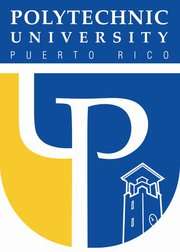Polytechnic University of Puerto Rico
 | |
| Type | Private |
|---|---|
| Established | 1966 |
| President | Ernesto Vázquez Barquet |
| Undergraduates | 5,195 |
| Postgraduates | 721 |
| Location | San Juan, Puerto Rico |
| Campus | Urban |
| Colors | Blue and Yellow |
| Nickname | La Poli (Poly) |
| Mascot |
Castor (Beaver)  |
| Website | www.pupr.edu |
The Polytechnic University of Puerto Rico (PUPR) —commonly referred as Poly or La Poly in Spanish— is a private non-profit university located in San Juan, Puerto Rico. PUPR offers a broad range of technical degrees; specializing in engineering professions.
General information
Polytechnic University of Puerto Rico (PUPR) is a private non-profit institution specializing in Engineering, Architecture, Landscape Architecture, Land Surveying and Geomatics, and Business Administration.[1] The main campus is located in the island's financial district which is the very core of metropolitan San Juan.[1] and its Online Campus in Miami Florida and Orlando.
Within the United States and its territories, the Polytechnic University of Puerto Rico is the second largest institution of higher education graduating Hispanic engineers.[2] Today, more than 40% of the graduating engineers in Puerto Rico are alumni of the Polytechnic University. Currently, there are nearly 6,000 students at the San Juan campus.[1]
PUPR is accredited by the Council of Higher Education of Puerto Rico, Middle States Association of Colleges and Schools, National Architectural Accrediting Board (NAAB), the Landscape Architectural Accreditation Board (LAAB) and the International Assembly for Collegiate Business Education (IACBE). In addition, five of PUPR's engineering programs are accredited by the Accreditation Board for Engineering and Technology (ABET) and two more programs are currently engaged in the preliminary accreditation process as required by ABET. These five engineering programs accredited by ABET are the first ones offered by a private institution in Puerto Rico that have received such a recognition.
In June 1–3, 2009 attended the conference organized by the National Security Agency (NSA) and the Department of Homeland Security (DHS) in Seattle, Washington to receive the certificate as a designated National Center of Academic Excellence in Information Assurance Education (CAE/IAE) for the years 2009 - 2014 and the Committee on National Security Systems (CNSS) certification. CNSS certification complies with the standards set by the US government's Committee on National Security Systems.
PUPR moved three steps higher in its history of success. In its persistent effort of providing opportunities for individuals from diverse backgrounds to achieve their personal academic goals, in addition to the Middle States Commission of Higher Education of the Middle States Association of Colleges and Schools (MSCHE of MSACS) full accreditation; PUPR obtained the accreditation of three School of Engineering and Geomatic Science programs submitted to the Accreditation Board for Engineering and Technology (ABET, Inc,) accreditation process for the first time; www.abet.org. Additionally, ABET extended the accreditation to the five oldest engineering programs.
The School of Engineering and Geomatic Science of PUPR now has eight programs accredited by the Engineering Accreditation Commission and one by the Applied Science Accreditation Commission of Accreditation Board for Engineering and Technology (ABET, Inc.), as follows:
| PROGRAM ACCREDITED | OCCASION | COMMISSION |
|---|---|---|
| Chemical Engineering (BS) [2006] | First Time | EAC |
| Computer Engineering (BS) [2006] | First Time | EAC |
| Land Surveying and Mapping (BS) [2006] | First Time | ASAC |
| Environmental Engineering (BS) [2002] | Second Time | EAC |
| Civil Engineering (BS) [1996] | Third Time | EAC |
| Electrical Engineering (BS) [1996] | Third Time | EAC |
| Industrial Engineering (BS) [1996] | Third Time | EAC |
| Mechanical Engineering (BS)[1996] | Third Time | EAC |
Additionally, the School of Architecture is accredited by the National Architectural Accrediting Board (NAAB), the School of Landscape Architecture by the Landscape Architectural Accreditation Board (LAAB) and the School of Management is accredited by the International Assembly for Collegiate Business Education (IACBE).
Academic Information
Polytechnic University of Puerto Rico (P.U.P.R.) is a private, non-profit, coeducational, nonsectarian institution founded in 1966. At present it is the largest private Engineering School in Puerto Rico and the only one in San Juan, the Capital of Puerto Rico. It is also the largest private Hispanic Serving Engineering School in the United States and its territories.
All programs at PUPR are authorized by the state licensing agency (Puerto Rico Council on Higher Education) and accredited by the Commission of Higher Education of the USA Middle States Association of Colleges and Schools (MSACS, 2005). Its engineering programs in Chemical, Civil, Computer, Electrical, Environmental, Industrial, Mechanical as well as Land Surveying and Mapping are accredited by the Accreditation Board of Engineering and Technology (ABET). The Architecture Program is accredited by the National Architectural Accrediting Board (NAAB); and the School of Management by the International Assembly for Collegiate Business Education (IACBE).
Engineering college description and special characteristics
PUPR is the largest private Hispanic engineering school in all of the United States and Puerto Rico and the only engineering school in the metropolitan area of San Juan. Since its inception, PUPR has graduated approximately 4,500 Hispanic engineers and surveyors.
Currently, the College of Engineering is 80% of the total PUPR undergraduate enrollment with 4,566 students. This enrollment will rank PUPR on the American Society for Engineering Education (ASEE) enrollment in engineering survey as the 20th largest engineering college in the U.S. and its territories. [3]
References
Notes
External links
Coordinates: 18°25′21″N 66°03′20″W / 18.42250°N 66.05556°W